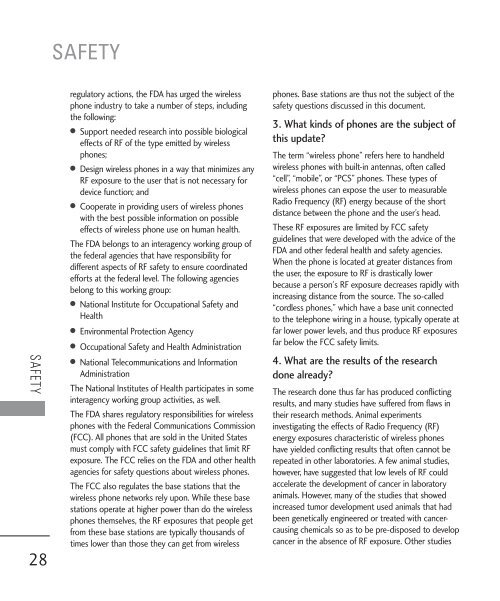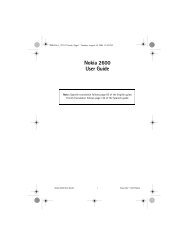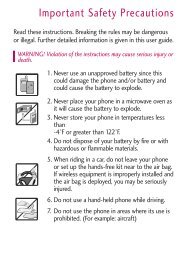Create successful ePaper yourself
Turn your PDF publications into a flip-book with our unique Google optimized e-Paper software.
SAFETY<br />
28<br />
SAFETY<br />
regulatory actions, the FDA has urged the wireless<br />
phone industry to take a number of steps, including<br />
the following:<br />
● Support needed research into possible biological<br />
effects of RF of the type emitted by wireless<br />
phones;<br />
● Design wireless phones in a way that minimizes any<br />
RF exposure to the user that is not necessary for<br />
device function; and<br />
● Cooperate in providing users of wireless phones<br />
with the best possible information on possible<br />
effects of wireless phone use on human health.<br />
The FDA belongs to an interagency working group of<br />
the federal agencies that have responsibility for<br />
different aspects of RF safety to ensure coordinated<br />
efforts at the federal level. The following agencies<br />
belong to this working group:<br />
● National Institute for Occupational Safety and<br />
Health<br />
● Environmental Protection Agency<br />
● Occupational Safety and Health Administration<br />
● National Telecommunications and Information<br />
Administration<br />
The National Institutes of Health participates in some<br />
interagency working group activities, as well.<br />
The FDA shares regulatory responsibilities for wireless<br />
phones with the Federal Communications Commission<br />
(FCC). All phones that are sold in the United States<br />
must comply with FCC safety guidelines that limit RF<br />
exposure. The FCC relies on the FDA and other health<br />
agencies for safety questions about wireless phones.<br />
The FCC also regulates the base stations that the<br />
wireless phone networks rely upon. While these base<br />
stations operate at higher power than do the wireless<br />
phones themselves, the RF exposures that people get<br />
from these base stations are typically thousands of<br />
times lower than those they can get from wireless<br />
phones. Base stations are thus not the subject of the<br />
safety questions discussed in this document.<br />
3. What kinds of phones are the subject of<br />
this update?<br />
The term “wireless phone” refers here to handheld<br />
wireless phones with built-in antennas, often called<br />
“cell”, “mobile”, or “PCS” phones. These types of<br />
wireless phones can expose the user to measurable<br />
Radio Frequency (RF) energy because of the short<br />
distance between the phone and the user’s head.<br />
These RF exposures are limited by FCC safety<br />
guidelines that were developed with the advice of the<br />
FDA and other federal health and safety agencies.<br />
When the phone is located at greater distances from<br />
the user, the exposure to RF is drastically lower<br />
because a person's RF exposure decreases rapidly with<br />
increasing distance from the source. The so-called<br />
“cordless phones,” which have a base unit connected<br />
to the telephone wiring in a house, typically operate at<br />
far lower power levels, and thus produce RF exposures<br />
far below the FCC safety limits.<br />
4. What are the results of the research<br />
done already?<br />
The research done thus far has produced conflicting<br />
results, and many studies have suffered from flaws in<br />
their research methods. Animal experiments<br />
investigating the effects of Radio Frequency (RF)<br />
energy exposures characteristic of wireless phones<br />
have yielded conflicting results that often cannot be<br />
repeated in other laboratories. A few animal studies,<br />
however, have suggested that low levels of RF could<br />
accelerate the development of cancer in laboratory<br />
animals. However, many of the studies that showed<br />
increased tumor development used animals that had<br />
been genetically engineered or treated with cancercausing<br />
chemicals so as to be pre-disposed to develop<br />
cancer in the absence of RF exposure. Other studies









